Sorcery! – Review
by Mark R
|
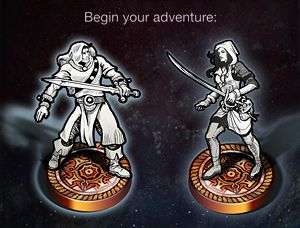 If you’re of a certain age, and have a penchant for all things fantasy, there are two things that will undoubtedly have taken up much of your childhood: text adventures, and ‘choose your own adventure’ books. On the off chance that you’ve never heard of the phrase, these Fighting Fantasy books were pioneered by a couple of gaming enthusiasts by the name of Steve Jackson and Ian Livingstone, relying on the reader to make split-second decisions – often accompanied by a dice roll – to determine which page they would next turn to in order to continue on their quest. It may sound archaic and bland to those growing up with DVDs, Segways, and porn without staples, but in the early 1980s it was an incredible concept that paved the way for others to emulate.
If you’re of a certain age, and have a penchant for all things fantasy, there are two things that will undoubtedly have taken up much of your childhood: text adventures, and ‘choose your own adventure’ books. On the off chance that you’ve never heard of the phrase, these Fighting Fantasy books were pioneered by a couple of gaming enthusiasts by the name of Steve Jackson and Ian Livingstone, relying on the reader to make split-second decisions – often accompanied by a dice roll – to determine which page they would next turn to in order to continue on their quest. It may sound archaic and bland to those growing up with DVDs, Segways, and porn without staples, but in the early 1980s it was an incredible concept that paved the way for others to emulate.
My first Fighting Fantasy novel was Deathtrap Dungeon which, sporting a ferocious Jabba The Hutt lookalike on the cover, sucked away my lunch times and free periods during my second year of high school as I played and replayed it, making different decisions each time. With laptops back in 1984 being more akin to desktops inside oversized suitcases, this was pretty much the only way to take the immersion and imagination of the text adventure into a mobile format.
Around the same time, Steve Jackson teamed up with illustrator John Blanche to produce his own miniseries outwith the standard Fighting Fantasy series, a sidestep he named Sorcery. Now, some thirty years later, Sorcery has been redesigned to work with mobile devices and bridges the gap between the classic text adventure, graphic adventures, and the more recent point-and-click adventures. Cambridge-based indie developers, Inkle Studios, have taken on the perilous quest of translating one of the most-loved Fighting Fantasy series to digital format and, thankfully, cared enough to not only do it well but also surpass expectations.
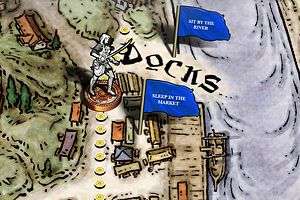 Set in the kingdom of Analand, in the south west of Old World, you have been tasked to retrieve the Crown of Kings from the Archmage who stole it in an effort to build a powerful army and control the region. As with all good adventure stories, you’re not some steroid-fuelled war beast with more weaponry than a small army; you’re a simple warrior with bugger all gold, no supplies, and a stamina metre that’s far from being generously endowed so your struggle to recover the aforementioned crown really is a struggle. As a warrior, however, combat is one of your primary roles along the way as you tackle all manner of hoodlums and medieval ASBO holders.
Set in the kingdom of Analand, in the south west of Old World, you have been tasked to retrieve the Crown of Kings from the Archmage who stole it in an effort to build a powerful army and control the region. As with all good adventure stories, you’re not some steroid-fuelled war beast with more weaponry than a small army; you’re a simple warrior with bugger all gold, no supplies, and a stamina metre that’s far from being generously endowed so your struggle to recover the aforementioned crown really is a struggle. As a warrior, however, combat is one of your primary roles along the way as you tackle all manner of hoodlums and medieval ASBO holders.
Rather than go with the somewhat obvious choice of rolling dice to decide the outcome of battles, however, Inkle have taken an entirely new approach which is more reliant on pre-emptive manoeuvres. There is still an element of luck involved, as you can’t ever truly know what your opponent is about to do, but each move you make is your own choice and you’re never left at the mercy of a random seed. With your opponent on the right, and your character on the left – in a 2D cut-out style display – you’re presented with a slider which will determine how your turn will play out. With the slider all the way to the left, you’ll take a heavy defensive stance. Move the slider all the way to the right and you will go for an all-out attack.
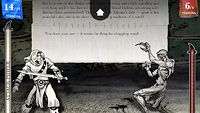 |
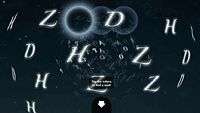 |
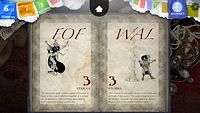 |
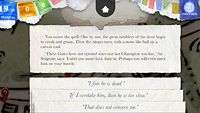 |
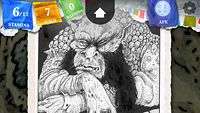 |
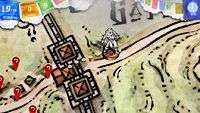 |
Each turn during combat mode will result in your stamina taking a hit, and that value will depend on whether you were in attack or defense mode and will also be affected by whatever move your opponent made. Taking the defensive stance while your opponent does the same will invariably end up with both parties losing only one stamina point each whereas a heavy attack in your direction could knock a huge chunk off, and it’ll take a while before you manage to replenish your store. Similarly, opting for a heavy attack will let you know in advance how many points will be used up and, bearing in mind that your opponent may also go for a heavy attack during that turn, this may not necessarily be beneficial to you.
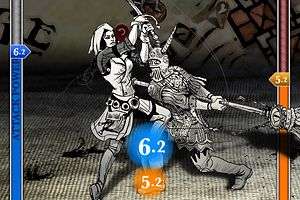 To simplify the combat mechanism, you’re hoping that whenever you take a defensive stance it’ll be met with an attack from your opponent so that you suck as much stamina from them as possible but are protected enough that it’ll have minimal effect on your own stats. The opposite is true for an attack move where your stamina trade-off will hopefully be met with a lacklustre attack on the other side so their points are wasted if your blow is stronger than theirs – they’ll have used up a lot in an attack move, failed, and you’ll have taken additional points from them from your own blow. It’s all very pen-and-paper in essence, but plays out beautifully on screen and does give you enough to think about prior to making your move.
To simplify the combat mechanism, you’re hoping that whenever you take a defensive stance it’ll be met with an attack from your opponent so that you suck as much stamina from them as possible but are protected enough that it’ll have minimal effect on your own stats. The opposite is true for an attack move where your stamina trade-off will hopefully be met with a lacklustre attack on the other side so their points are wasted if your blow is stronger than theirs – they’ll have used up a lot in an attack move, failed, and you’ll have taken additional points from them from your own blow. It’s all very pen-and-paper in essence, but plays out beautifully on screen and does give you enough to think about prior to making your move.
As well as standard melee confrontations, you also have a number of spells at your disposal which are determined by how much you’ve learned along the way. All spells comprise of a three-letter word which loosely describe what is about to be cast, such as FOG to create a confusing mist, ZAP to smack with a bolt of energy, FOF to generate a temporary force field, and EGG to force your combatant to eat a balut egg. Or maybe not. Either way, going into spellcasting mode is trickier than need be as it presents you with a hovering globe of letters and it’s down to you to select these to build your spell. Sadly, they don’t always work and it’s never exactly clear why. Normally this sort of thing would detract from the rest of the game and leave a rather bitter taste in the mouth but, as with the original Fighting Fantasy series, the enjoyment is in the story and not the confrontations you experience along the way.
It’s not all about combat though, and much of what you do perfectly reflects the source material where every occurrence is met with a series of decisions, each with their own outcome. Being digital, however, your choices don’t transport you from one page to another in order to see the result and, instead, every decision is represented by a torn fragment of paper which is then stitched to the story above as it continues to develop. It may sound simple enough, but it’s beautifully executed and reminds you that, while you’re experiencing something that was written some thirty years ago, you’re doing so very much in the here and now.
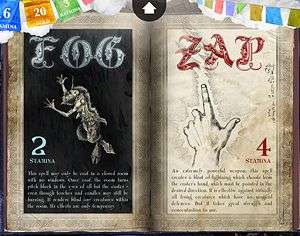 Rather than be guided by the narrative, the main view of Sorcery is an overhead map showing your immediate and surrounding areas along with various map markers to represent discovered locations and those you have been given a choice of visiting. Moving to a location is as simple as dragging your character cut-out from its present spot to your chosen destination, so there’s never a linear path being forced down your throat. Wander into an area without the necessary weaponry and/or skills, however, and you’ll meet the same untimely demise as you would in the books and you’re dropped back to your previous save for another attempt. Similarly, should you balls up in combat, the option is there to replay the scenario until such times as you’re able to walk way as a relatively unharmed victor.
Rather than be guided by the narrative, the main view of Sorcery is an overhead map showing your immediate and surrounding areas along with various map markers to represent discovered locations and those you have been given a choice of visiting. Moving to a location is as simple as dragging your character cut-out from its present spot to your chosen destination, so there’s never a linear path being forced down your throat. Wander into an area without the necessary weaponry and/or skills, however, and you’ll meet the same untimely demise as you would in the books and you’re dropped back to your previous save for another attempt. Similarly, should you balls up in combat, the option is there to replay the scenario until such times as you’re able to walk way as a relatively unharmed victor.
With so much of Sorcery weighing on the wonderful storytelling of Steve Jackson, it’s difficult to go into much detail without ruining much of the enjoyment. This is, ultimately, a magical hand reaching into the past and tearing a pioneering book series from its place in history into the modern day and doing so without destroying anything that made the Fighting Fantasy series so enjoyable. If anything, dare I say it, there’s a lot more to offer in terms of future potential. Sure, it may mean that much of the story requires very little imagination as it is now playing out in front of you rather than in your own head, but it also makes it a great success in terms of turning it into an actual game rather than a book.
As someone who grew up hiding his Fighting Fantasy book down the side of his mattress along with a torch, looking forward to slaying beasts under cover of a 13.5-tog duvet as the story played out in his head, the idea of taking the series to tablet technology was daunting at best. Like someone knowing that the Batman movie they’re about to watch was made by the same guy who gave us The Incredible Shrinking Woman, the trepidation was indescribable. Thankfully, Inkle have done Steve Jackson, the Fighting Fantasy series, and its loyal fanbase proud. If Jackson and Livingstone were to come up with the idea of the choose-your-own-adventure now, I’m sure this is exactly what they’d do.
Pros- Compelling story
- Beautifully designed
- Intuitive controls
- Combat is perfectly executed
- Excellent presentation of the original story
- Hand-drawn graphics
- Stays true to the source material
- Spellcasting was just a bit odd
- Crashed a few times
For fans of Steve Jackson and Ian Livingstone's original Fighting Fantasy series, Inkle Studios' interpretation of Sorcery is one of those things that could have ended up being a disaster but, instead, was an outright triumph. From the hand-drawn 2D woodcut-style graphics to the way in which each decision stitches with the story thus far, everything is exactly how it should be.
For anyone unfamiliar with the series, no prior knowledge is necessary and this can be picked up and played with relative ease. Much like how an audio book can transform a novel into something entirely different, Sorcery should be treated as a fully immersive book with the potential to pull the reader in to the story in an entirely different way. A great way to spend time on a tablet without resorting to games with "Saga" in the title.
Last five articles by Mark R
- From Acorns to Fish
- Alone In The Dark
- Why Borderlands is Better Than Borderlands 2
- Falling Short
- The Division: A Guide to Surviving the Dark Zone Solo

















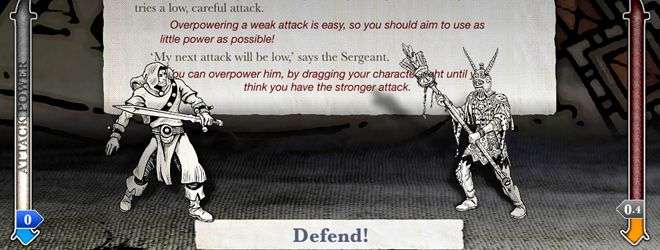
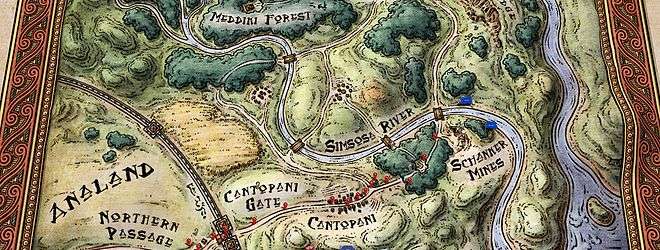
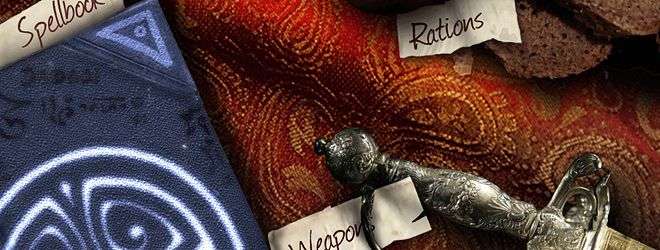






There are no comments, yet.
Why don’t you be the first? Come on, you know you want to!